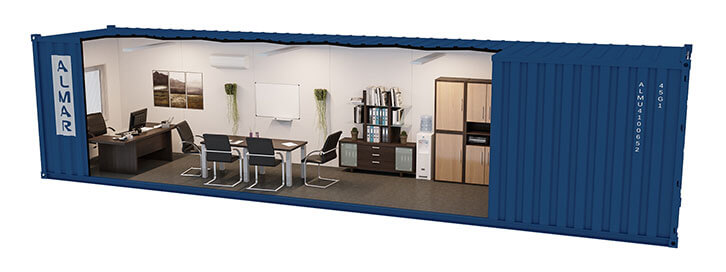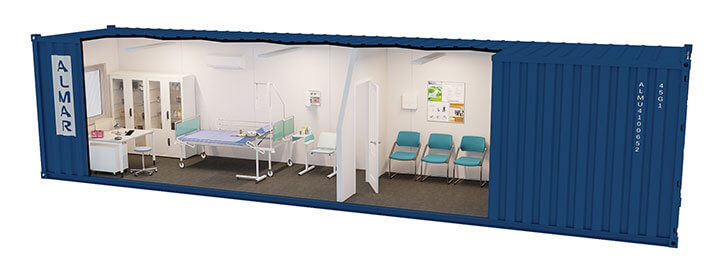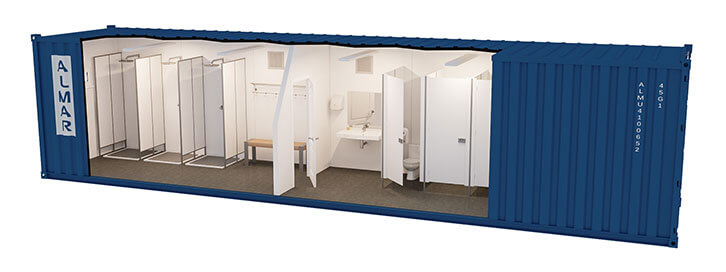

Converted or fabricated containers offer the ideal solution for tourist camps in game reserves across East Africa, aligning with the government's requirement of minimising the environmental impact throughout the 10-year permit period. Subsequently, the camp can either be dissolved or undergo further development and improvements. Here's why converted containers are the most environmentally-sensitive choice:
Converted containers provide an innovative and environmentally-sensitive solution for tourist camps in game reserves throughout East Africa. Their sustainable attributes help meet the government's requirement for a minimal environmental footprint, while still allowing for flexibility, adaptability, and the potential for further development or improvements within the 10-year permit period.
For more information about converted containers email sales.ke@almar.co.ke or phone +254 719 675 272.
Converted office containers have become a popular trend in Kenya as they offer a cost-effective and flexible solution to businesses that need additional workspace or a temporary office/s.
Almar East Africa specialises in the conversion of shipping containers into office spaces. The conversion process is done in-house by Almar’s team of specialists and this involves creating windows and doors in the container, adding insulation and ventilation, and installing electrical and plumbing systems. The interior is customised to meet the specific needs of the business, with options such as partitions, shelving, and lighting.




Almar converted office containers have several advantages over traditional office spaces. They are durable and can withstand harsh weather conditions. They are also portable and can be easily transported to different locations, making them suitable for businesses that need to move frequently or for temporary set-ups. Ideal for construction, housing or mining projects that require infrastructure for staff working on the development. Converted office containers offer a practical and cost-effective solution.
Container offices, also known as modular offices or converted shipping container offices, offer several benefits to businesses and organisations. Here are some of the key advantages of using a container office:
Flatpack containers, also known as modular or collapsible containers, are also an option for office containers.
Almar Flatpack Containers is a modular system that allows for the quick and simple assembly of a temporary or semi-permanent facility. Almar East Africa offers turnkey solutions in certain regions including office design, camp design, delivery, and assembly ensuring that you can focus on your core offering leaving the workplace and housing of your staff to the Almar East Africa team.


Due to the interchangeable panel system and modular nature of the flatpacks they can be used to construct multistorey buildings or office blocks, and once joined allow for a number of layout design options.
The Almar flatpack is a modular solution built within the dimensions of a standard 20’ container. Each Flatpack unit comes supplied with insulated panels, full electrics, vinyl flooring, 2 x windows, and 1 door.
For more information contact the Tel: +254 719 675 272 and sales.ke@almar.co.ke.
Almar’s custom-made, high-quality fabrication projects are implemented in partnership with the customer from idea inceptions to site mobilisation. These tailored container conversions are created by a team of ‘in-house’ engineers and design experts.
Eduardt Ruhling, MD for Almar’s East Africa Conversions, says that the team involved in creating bespoke container fabrications are highly skilled in their areas of expertise – design, engineering, manufacturing, and aesthetics.
“We specialise in bespoke container fabrications with the focus being on quality finishes and workmanship, and this is something that we take great pride and pleasure in. It is so rewarding to see the final product, created specifically for the end-use, in ‘action’ whether it be a coffee shop, a retail store, or a double-story office,” explains Eduardt.
According to Richard Bell, Operations Director of Rural Retail for the One Acre Fund in Kenya, Almar played a key role in helping them achieve rapid expansion of their rural retail network. “We appreciate the good levels of communication and collaborative approach to addressing issues when they arise. The team is great to work with - responsive, professional, and takes great pride in their work,’’ comments Richard.




Another customer, Ritesh Doshi, CEO of Spring Valley Coffee says, “Almar was a thought partner as we designed and built our container café. They clearly know their craft and gave us the best advice for our needs. Their commitment to quality is evident, and the outcome is reflective of our brands and fit for purpose.”


For more please information please contact Eduardt on +254 700 036 742 or +254 719 675 272 or email eduardt@almar.co.ke.
It can be a false economy to purchase a container office outright for a short contract away from base. That’s because it’s not always easy to provide the assurances the reseller market needs. Most purchasers prefer to source their rental office containers from reliable suppliers including Almar Container Group. We supply our intermodal shipping containers with rock solid warranties and all your questions answered.

We need flexibility above most things in a dynamic economy. What seemed the ideal location may no longer prove to be the right decision as a project rolls out. Intermodal shipping containers are designed with the intention of moving around. They have secure lifting points at all eight corners and are strong enough to support far more weight than a fitted office.
Hence intermodal shipping containers make perfect temporary office accommodation. Moreover, our rental office containers may come complete with electrical, plumbing and drainage reticulation. All you need do is connect them with the necessary services. How hassle-free is that, compared to erecting a prefabricated building that may not disassemble, move, and reassemble again properly?
Find more answers to your questions here.


We extend the life of intermodal containers by finding new uses for them. We believe in recycling things because new construction comes with carbon costs. Our robust, modular range includes:
Speak to Almar Container Group in confidence for all your rental office container solutions soon.